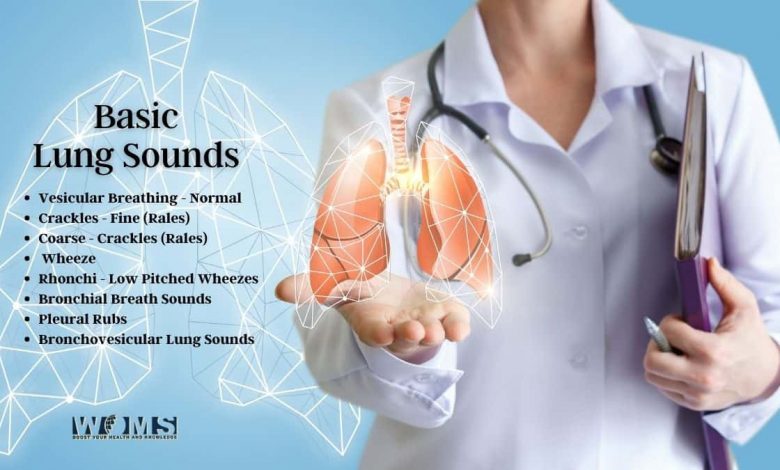Basic Lung Sounds

Vesicular Breathing – Normal
Vesicular breathing is the breathing in which the expiration is shorter than the inspiration period with no pause in between. The inspiration is 2 to 3 times longer than the expiration. During the expiration, the quality of sound fades rapidly. It has a lower pitch and is softer in nature.
During the inspiration, the sound is of higher intensity and rustling in quality. It becomes softer during the expiration period. Its auscultation occurs in all the areas of auscultation but mostly above the thorax. Vesicular breathing is normal breathing. It is the most commonly heard lung sound.
Crackles – Fine (Rales)
Fine crackles, also called pulmonary crackles or rales, are the rattling sounds perceived during the late inspiration period. It is one of the basic lung sounds that we hear. They feel like the sound of hair rubbing together. Fine crackles arise in the smaller alveoli or the airways due to the collapse of these airways by some exudate or fluid.
They are high-pitched and soft in nature. It can be heard only by auscultating with a stethoscope. Fine crackles are not normal and are heard in respiratory diseases like pulmonary fibrosis, congestive heart failure, interstitial pneumonia. They indicate extra fluid over the lungs, which might be due to aspiration, pneumonia, chronic bronchitis, etc.
Coarse Crackles – (Rales)
Coarse crackles have a lower pitch than the fine crackles and are comparatively louder. They are heard during the early inspiration period and sound moist or sturdy. It can last for a longer period. They show the accumulation of extra fluid over the lungs resulting from aspiration, pulmonary edema, bronchitis, etc. They are due to the pathological processes taking place in the larger respiratory spaces or bronchioles.
Mucous in the large bronchioles as in Chronic obstructive pulmonary disease (COPD) can result in coarse crackles or rales. Coarse crackles are also indicative of Adult respiratory distress syndrome (ARDS). Coughing can alter the quality of coarse crackles, but they do not disappear completely.
Wheeze
Wheeze is a kind of a whistling sound. It is by the narrowing and inflammation of the airways and we can hear both during the inspiratory and expiratory phases. This is an indication of some kind of obstruction in the air spaces or narrowing of these spaces. It is a pathological sound. We hear Wheezing is most common during serious respiratory diseases like asthma and chronic obstructive pulmonary disease (COPD), requiring proper diagnosis and treatment. Wheezes have a musical or squeaky aspect to them. Wheezing feels like whistling when a person is breathing. The high-pitched wheezing is heard most commonly during expiration and sometimes during inspiration.
Ronchi – Low Pitched Wheezes
Ronchi( plural for ronchus) are low-pitched wheezes. They are coarse and rattling in nature. They are due to some abnormal secretions in the bronchial airspaces that cause blockage or obstruction. Ronchi resembles the sound of snoring. Ronchi sound’s observation can be during respiratory disorders like chronic bronchitis, chronic obstructive pulmonary disease (COPD), pneumonia, bronchiectasis, or cystic fibrosis.
When the obstruction or blockage occurs in intrathoracic airways, it is as expiratory Ronchi. There are two types of Ronchi. The high-pitched Ronchi are referred to as sibilant Ronchi, and the low-pitched Ronchi are called sonorous Ronchi. Coughing alters the nature of Ronchi.
Bronchial Breath Sounds
Bronchial breath sounds are normal in respiration. Their auscultation occurs above the trachea. Although the bronchial breath sounds are normal, it is consolidation when we hear it in some areas away from their normal findings. Consolidation is present in pneumonia or lung compression.
These conditions make the lung tissues dense. Sometimes we can also hear the bronchial breath sounds in the peripheral areas where normally vesicular sounds are present. Bronchial breathing has a long expiratory phase, and the sounds are larger. In the condition of health, we can hear these sounds only above the large air spaces like the trachea. Bronchial sounds consist of higher frequency components.
Pleural Rubs
Pleural rubs are abnormal lung sounds. We hear these sounds when there is an inflammation of the lung’s pleural layer by the rubbing together of these layers. Pleural rubs are harsh and grating in nature. We can hear Pleural friction rubs during both inspiration and expiration. These have a low pitch.
Pleural rubs are common in respiratory diseases like pneumonia, pulmonary embolism, malignant pleural disease, etc. There is a narrow fluid-present space, the pleural cavity between the pleural layers of the lung. When there’s is inflammation in this space, or the lubrication between them is absent, we can hear pleural rubs, and observation of pain is there.
Bronchovesicular Lung Sounds
Bronchovesicular lung sounds are tubular in nature. We can hear bronchovesicular lung sounds in the chest’s posterior portion, usually between the central part of the anterior chest and the scapulae. Compared to bronchial lung sounds, bronchovesicular sounds are softer in nature.
Bronchovesicular sounds have equal inspiratory and expiratory phases. The difference in the pitch of the sound is present during the expiratory phase. They are normal breathing sounds. The auscultation can be throughout the lung area/field, especially near the trachea and the alveoli. They have a medium pitch. Bronchiovesicular sounds are the intermediate sounds between bronchial and vesicular breathing.